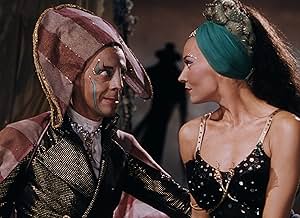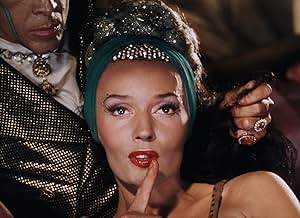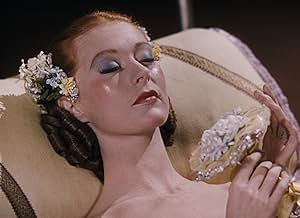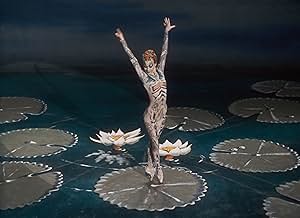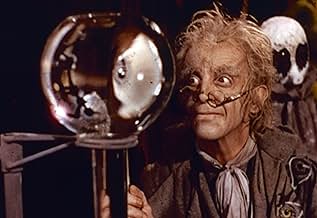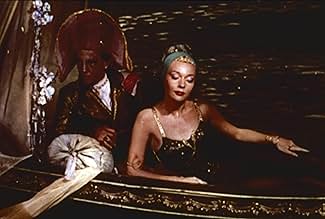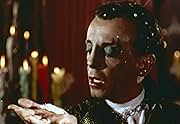अपनी भाषा में प्लॉट जोड़ेंA melancholy poet reflects on three women he loved and lost in the past: a mechanical performing doll, a Venetian courtesan, and the consumptive daughter of a celebrated composer.A melancholy poet reflects on three women he loved and lost in the past: a mechanical performing doll, a Venetian courtesan, and the consumptive daughter of a celebrated composer.A melancholy poet reflects on three women he loved and lost in the past: a mechanical performing doll, a Venetian courtesan, and the consumptive daughter of a celebrated composer.
- 2 ऑस्कर के लिए नामांकित
- 2 जीत और कुल 3 नामांकन
- Giulietta
- (as Ludmilla Tcherina)
- …
- Spalanzani
- (as Leonide Massine)
- …
- Olympia
- (गाने की आवाज)
- …
- Giulietta
- (गाने की आवाज)
- …
- Nicklaus
- (गाने की आवाज)
- …
- Antonia's Mother
- (गाने की आवाज)
- Spalanzani
- (गाने की आवाज)
- …
फ़ीचर्ड समीक्षाएं
However, unlike THE RED SHOES, HOFMMAN is a much colder experience. For a film about the joys and sufferings of love and desire, the whole thing is quite remote, never reaching the emotional depth of other Powell and Pressburger films. The whole thing feels overlong and if you aren't an opera fan, you aren't likely to take to the music either.
The three sequences which make up the runtime are uneven: the Olympia story is whimsical and fun though a touch overlong; the Giuletta sequence is gothic and well-paced; the Antonia sequence is just about the worst. Olympia and Giuletta benefit from having charismatic performers at their center in Moira Shearer and Ludmilla Tcherina, but Ann Ayars lacks any real personality as the dying songstress, making the last section such a drag to sit through.
By the time the film came to its close, I was more than ready for it to be done with. No doubt, a lot went into the sets, costumes, special effects, and camera work. I must also give a shout-out to Robert Rounseville as Hoffman: he carries himself well throughout the long running time. But I'm sorry to be the naysayer: when a movie is over two hours long, I need more than gorgeous visuals to see me through it.
The story begins in Nuremberg as Hoffmann watches the object of his affections, Stella (Moira Shearer) dance a ballet. During the intermission, he goes into a tavern and tells the customers about his three major affairs.
Opera singers, with two exceptions, dub the stars, who are mostly from the ballet world; several will be familiar from The Red Shoes: Moira Shearer, Ludmilla Tcherina, Robert Helpmann, Léonide Massine, and Frederick Ashton. Only Hoffmann, Robert Rounsville, and Antonia, Anne Ayars, do their own singing. The rest of the vocals are provided by Dorothy Bond, Margherita Grandi, Monica Sinclair, Joan Alexander, Grahame Clifford, Bruce Dargavel, Murray Dickie, Owen Brannigan, Fisher Morgan, and Rene Soames.
Both the singing and dancing are absolutely magnificent, the beautiful Shearer dancing much better than she did in The Red Shoes several years earlier, and Powell and Pressburger fill the opera with fantastic effects and colors. My favorite is Shearer's doll ballet sequence, with the glorious coloratura singing of the Doll Aria by Dorothy Bond, a discovery of Sir Thomas Beecham, who conducts the orchestra. Tragically she was killed in a car accident the next year; she deserved to be one of the most famous sopranos who ever lived.
There are a couple of problems with this incredible piece. It's done in English, which due to the tamber of the high soprano voice, can make it difficult to understand. So people who know the opera would probably enjoy it the most. Secondly, it's not paced very well - there are some very draggy sections; some of the chorus work could have been cut.
The overall effect for the eyes and ears is fabulous, but "The Tales of Hoffmann" leaves one depressed for how far we've fallen culturally in this world. Imagine mounting this film today. How many people would attend? Five?
In "The Tales of Hoffmann", Robert Rounsevill stars as E.T.A. (Ernst Theodore Amadeus) Hoffmann, the poet and writer who tells three stories of his great but unhappy loves all ending tragically thanks to the meddling of his enemy, a supernatural villain (Robert Helpmann as quadruple evil, Lindorf, Coppelius, Dapertutto and Dr Miracle). Objects of Hoffmann's love and admiration include Olympia the wind-up doll (Moira Shearer who also plays Stella the dancer, the fourth and yet another Hoffmann's misadventure), Giulietta, the Venetian courtesan who sails away after trying to capture Hoffmann's soul (Ludmilla Tchérina -absolutely brilliant as the siren and the seductress who elegantly walks over the dead bodies, literally), and Antonia the beautiful opera-singer with the fatal voice and deadly illness. One of the greatest choreographers and dancers of the last century, Léonide Massine shines in three absolutely different roles demonstrating his talent as a dancer, strong emotions and tremendous humor.
What makes "The Tales of Hoffmann" not just an ordinary screen adaptation but the stunning unforgettable event, the film which had inspired the future famous directors George Romero and Martin Scorsese to become the filmmakers is the perfect combination of fantasy, classical music, ballet, singing, stunning visual effects, imaginative and often bizarre and even disturbing images that would fit a horror movie (deconstructing Olympia the doll is horrifying), incredible but calculated feast of colors, their mixture, the unique color palette to match each story, camera work that is so innovative and dynamic that even now, 56 years after the film was made, looks fresh and modern. The feast for eyes, ears, and feelings, "The Tales of Hoffmann" is the love child of incredibly talented people from different epochs and countries. The opera by Jacques Offenbach, the French composer is based on the dark romantic fairy tales by the German E.T. A. Hoffmann. The team of two directors known as "The Archers", the British Michael Powell and the Hungarian Jew Emeric Pressburger who had to flee his country before the WWII, and their international team of stars, color consultants, choreographers and production designers made this miracle happen. The last but not the least is legendary Sir Thomas Beecham conducting the Royal Philharmonic Orchestra.
क्या आपको पता है
- ट्रिवियाGeorge A. Romero, writer/director of नाइट ऑफ़ द लिविंग डेड (1968) and मृतकों की सुबह (1978) has cited this as his all-time favorite movie, saying that it was the one that originally inspired him to get into filmmaking.
- गूफ़Giulietta's necklace is turned from jewels to wax by Dapertutto, however, in a longer shot, it is briefly shown as jewels again, before a close-up, where it is wax again until Dapertutto changes it back to jewels.
- भाव
Chorus of Students: Some drink, drink, drink, drink, drink: do you hear us about? You lazy lout! We want some beer; we want some wine! Pour out the wine, and drink and drink till morning. Pour out the wine for drinking is divine. It is divine. We want some beer; we want some wine. We want some beer; we want some wine.
- क्रेज़ी क्रेडिटIn the end credits, main actors appear taking curtain calls next to the singers who dubbed them.
- इसके अलावा अन्य वर्जनThe complete 138-minute version was available in 16mm black and white early television prints. The complete 138-minute version was also available in 16mm Kodachrome (color) rental prints. The complete 138-minute soundtrack was available for many years on LP (London Records).
- कनेक्शनFeatured in The Late Show: Michael Powell (1992)
- साउंडट्रैकThe Tales of Hoffmann, A Fantastic Opera
Music by Jacques Offenbach
Arranged by Thomas Beecham (uncredited)
English libretto by Dennis Arundell
From the French text by Jules Barbier
Conductor: Thomas Beecham (as Sir Thomas Beecham Bart.) with The Royal Philharmonic Orchestra
Sung by Robert Rounseville, Dorothy Bond, Margherita Grandi, Ann Ayars (as Ann Ayars), Monica Sinclair, Joan Alexander, Grahame Clifford, Bruce Dargavel, Murray Dickie, Owen Brannigan, Fisher Morgan, Rene Soames, and The Sadler's Wells Chorus
टॉप पसंद
विवरण
बॉक्स ऑफ़िस
- US और कनाडा में सकल
- $91,930
- US और कनाडा में पहले सप्ताह में कुल कमाई
- $23,340
- 15 मार्च 2015
- दुनिया भर में सकल
- $1,40,714
- चलने की अवधि2 घंटे 13 मिनट
- पक्ष अनुपात
- 1.37 : 1
इस पेज में योगदान दें




